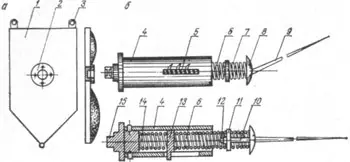Our dear readers, we told you about simulators and training devices practically all types of modern sports. But they completely forgot about fencers. But who, if not them, needs special devices for training and improving technology, as well as all sorts of devices for accurately determining whose injection was the first... In this article we will try to compensate for this annoying gap, and we will tell you with the help of what technical means the modern fencing lessons. How they help improve athletes' technique. And also how special training equipment and equipment for fencing work.
A simulator for improving fencing techniques.
The simulator allows you to simulate all possible positions of an opponent’s hand typical for a fencer.
The device (Fig. 1) has a platform 1 installed in a vertical position with the help of lugs 3. A threaded bushing 2 is pressed into the base for connecting the bushing 4 to the blade, which begins with a roller 15 with an external thread. Inside there is a thrust washer 13 with a clamping driver that fits into the slot of the sleeve 5. There is also an ejector spring 14 and part of the main support spring 6, one end of which is fixed on the support disk 13, and at the other end there is a thrust washer 11, which has an inner thread 12 with a diameter of 6 mm. The thread is intended for screwing in the blade shaft 10. The blade contains a guard 8 and a thrust spring 7. During lessons, the blade can make oscillatory movements and change the angle of inclination to the shaft.
Using this equipment for fencing, the roller 15 with the blade 9 is screwed into the sleeve 2 of the training base. By rotating the blade around the axis of the rod, the required position is set. By pressing the guard, the load-bearing and ejector springs 6 and 14 are exerted. The thrust washer is secured with a locking rod in the groove of the sleeve. This allows you to regulate the output of the carrier spring from the above bushing and the magnitude of its vibrations together with the blade.
A miniature simulator-informant is used for training fencers and epee fencers and is included in the mandatory standard equipment of each athlete.
This training equipment for fencing consists of the following elements: a miniature telephone body, a cord for connecting an electric sword. Schematic diagram of the simulator (Fig. 2): R1 = 15 kOhm; R2=3 kOhm; C1= 10.0 µF x 10 V; C2= 100.0 µF x 10 V; Tr - small-sized output transformer from a transistor radio; TLF—small-sized; VI - low-frequency transistor.
According to the principle diagram, the device is a transistor audio frequency generator with a small-sized telephone at the output. The desired generation frequency is set by selecting resistor R2. Three disk batteries connected in series are used as a power source. They can be replaced by any other voltage source of 3.5...9 V. Due to the low current consumption, one battery charge is enough for 90...100 hours of continuous operation. A correctly assembled circuit (shown in Figure 2) begins to function immediately and does not require special adjustments at all before each training lesson.
A small-sized telephone is installed in the fencer’s mask, and the device itself is placed on the athlete’s clothing. When an injection with a force of 750 g occurs, the contacts of the K1 electric sword close and the audio frequency voltage is sent to the phone in the form of a short-term sound signal. The duration of the pulse depends on the capacitance of the capacitor blocking the electric sword. Dimensions of the informant simulator 60X30X15 mm, weight 35 g.
In the following articles on our fitness site we will talk about other devices and training simulators, as well as elements of equipment for modern fencers. There is still a lot of interesting things ahead! Stay with us!
Post Views: 136


